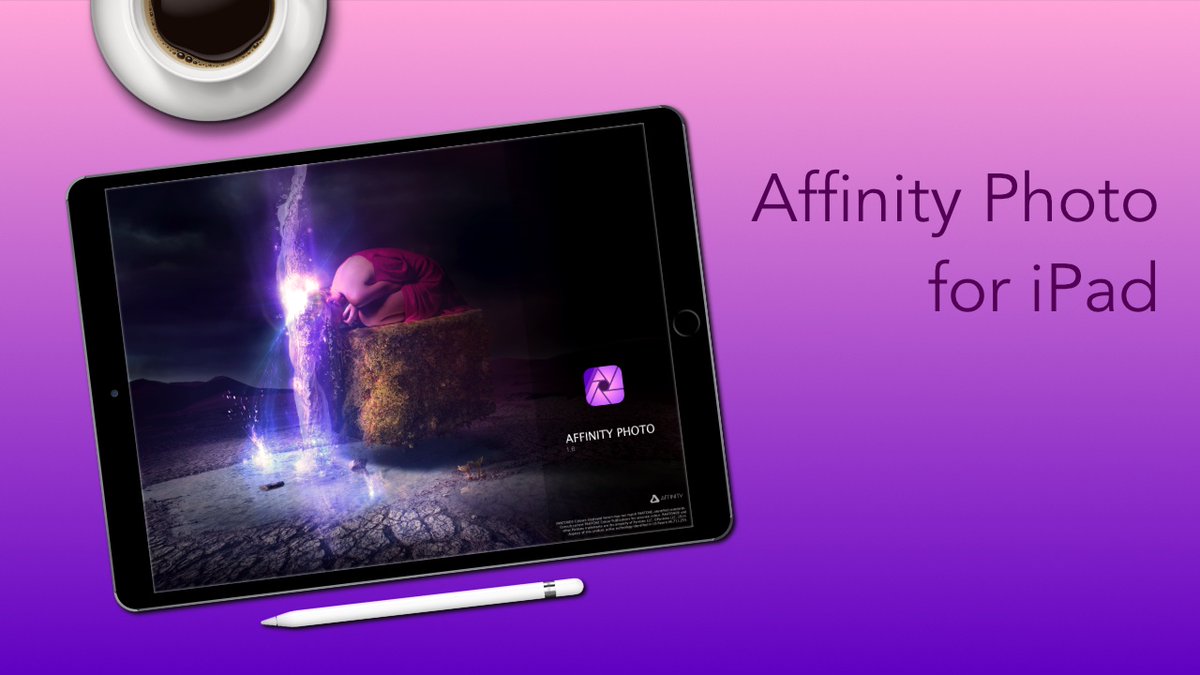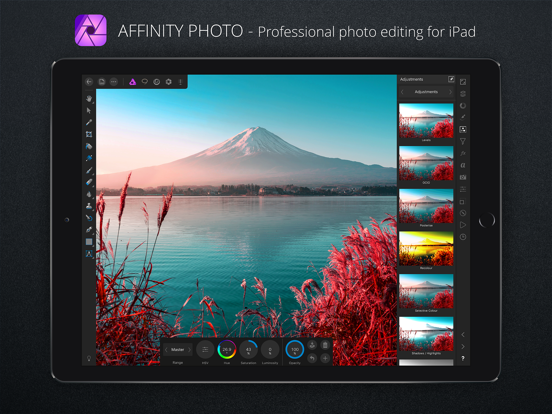Affinity Photo for iPad is a genuine desktop-grade, professional photo editing app. Completely reimagined for iPad with the same power as the desktop version and with complete file format compatibility, you can work across the same document wherever you are, without any compromise.
- Affinity Photo Ipad Pro Price
- Affinity Photo For Ipad Manual
- Ipad Pro Affinity Photo Editing Portrait
- Ipad Pro 12.9 Affinity Photo
Affinity Photo for iPad is a genuine desktop-grade, professional photo editing app. Completely reimagined for iPad with the same power as the desktop version and with complete file format compatibility, you can work across the same document wherever you are, without any compromise.

Now that the iPad is effectively a Macbook Pro 13' in a tablet form factor, are you all planning on taking advantage of this newfound power? Will the iPad version match 1:1 with its desktop counterpart? For example, I remember reading awhile back how you're planning on bringing 3D support to Affinity Photo. Photo manipulation tutorial on the iPad Pro using affinity photo. Affinity Photo for iPad tutorials Watch our collection of short video tutorials to help you get started with Affinity Photo for iPad. Photoshop para iPad Affinity Photo VS Photoshop. Woman in Black - iPad Pro Retouch (Affinity P.
PSD Import/Export
PSB Import
Unlimited Layers
Brush Support
PSD Smart Object Import
Customisable Keyboard Shortcuts
Affinity Photo Ipad Pro Price
No subscription and 50% off
Best of all, Affinity Photo for iPad does not require any subscription, it’s simply €21.99 – and right now available with 50% off!
Dodge, burn, inpainting, sponge, blur, sharpen, healing brushes, paint mixing brush – experience the incredible power and capabilities you would on desktop, on iPad.
CMYK, RGB8, RGB16, Greyscale, LAB and even RGB32. Work in any colour space, with full confidence that any documents taken from the Windows or macOS version will always render with 100% fidelity.
Take advantage of the full suite of selection tools, including lasso, magic wand and pen tool. Use advanced selection refinement to achieve perfect selections, even down to individual strands of hair.
Affinity Photo For Ipad Manual
Work with unlimited layers, including real-time blend modes with advanced range adjustments and simple drop zones to mask, clip, reorder and group all layer types. Text, vector, pixel and image layers are all fully supported.

Produce stunning composite images, including perfectly stitched panoramas. Use HDR merge with tone mapping for breathtaking results and even stack images with different focal lengths to create detailed macro photography.
Drag and drop stock imagery directly into your work and use the asset panel to store visualisation assets and more. All asset packs can be shared between Mac, Windows and iPad.
Edit and create brushes, with control over all dynamics supported by Apple pencil, and even import .abr brushes. Any brushes you create can be shared across desktop and iPad versions as well.
Curves, channel mixer, gradient map and more — you have a full library of 22 adjustment layers available with no compromise.
Use a huge selection of live filter layers, including blurs, lighting, distortions and deformations. You can even apply filters non-destructively, allowing you to reorder, mask and edit them at any time.
Develop RAW images in a 16-bit colour space, with lens corrections, advanced noise reduction, chromatic aberration reduction, curves adjustment, white balance adjustment, defringe and more.
Push, twirl, pinch and punch non-destructively within the Liquify Persona. Freeze areas to prevent adjustment, save meshes and reconstruct to your heart’s content. You can also apply a live liquify layer over the top of multiple layers.
Add text along a path. Explore a range of diverse typographical designs by creating a path from any line, curve or shape drawn with any of the line or shape tools.
Fully optimised for iPadOS, with the ability to drag and drop images from any location on iPad and full support for smart objects. You can even work directly on PSD files and save back to PSD.
Create your own shortcut keys using a keyboard attachment for an even more streamlined workflow.
No subscription and 50% off
Best of all, Affinity Photo for iPad does not require any subscription, it’s simply €21.99 – and right now available with 50% off!
Nobody needed to convince me that Apple’s at the top of its game when it comes to designing iPad hardware. The 2018 iPad Pro was so fast that more than two years later, it can handle more or less anything that you can throw at it. The 2020 iPad Pro was essentially the same speed—and it didn’t matter.
So here comes the 2021 iPad Pro, which is an even more extreme dunk in terms of features. Adding an M1 processor isn’t going to add the same boost as it did on the Mac side, because the iPad Pro was always powered by an energy-efficient Apple processor. But it’s still an upgrade of two processor generations, and that matters. A new display on the larger model allows Apple to set a new standard for brightness and dynamic range. Thunderbolt accelerates the iPad’s connectivity with other devices.
And yet, in 2021, it feels like the same story: Apple killed it on the hardware side, and the software…well, the software lags behind, to put it nicely. Apple built a spectacular sports car, but where are the roads to drive it on?
A Pro display for what?
The new 12.9-inch iPad Pro has a Liquid Retina XDR display powered by new mini LED technology. Adding this tech has a physical cost (the iPad has gone from 5.9mm to 6.4mm thick, and increased from 1.4 to 1.5 pounds) as well as a monetary one (starting at $1,099, it’s $100 more expensive).

The result, though, is a display that is bright and offers extreme dynamic range, a great boon to pro-level photographers and videographers alike. (It’s probably also going to be great to watch movies on.)
But more than five years after Apple introduced the iPad Pro, it’s telling that Apple is still demonstrating its gorgeous pro-level displays by using third-party apps. As impressed and enthusiastic as I am about the Affinity Designer apps and the video-editing power of LumaFusion, it’s still perplexing to see Apple show off yet another iPad Pro, with yet another impressive hardware upgrade, and Final Cut Pro is nowhere to be seen.
How are we supposed to interpret this? That Apple’s hardware team thinks the iPad is a vehicle into which incredible, cutting-edge features should be built, but that the teams responsible for Apple’s own professional-focused apps don’t think the iPad is worth the effort?
Thunderbolt support for what?
With the announcement of USB 4/Thunderbolt support on these new iPad Pro models, I’m thrown back to the past. In 2018, when Apple released the first iPad Pro with a USB-C port on the bottom, it didn’t update the software to read the entire contents of a thumb drive when you plugged it in. The hardware was willing, but the software was weak.
And here we are again. Thunderbolt adds even speedier connectivity, but for what? Faster photo and video imports? Okay, though once again, I’m reminded that Apple’s bread-and-butter pro media apps won’t run on these iPads.
Apple
How about external display support? The new iPad Pros can drive even larger external displays, including Apple’s Pro Display XDR. Third-party video apps can take advantage of this to display high-resolution video and even some analytical displays. Which is great, but if you want to display the iPad interface itself, it’ll just be a pillarboxed mirror of what’s on the iPad’s own screen.
That’s because, despite Apple adding support for external pointing devices and an on-screen pointer to the iPad a year ago, iPadOS doesn’t actually support moving apps off to a larger external display. The device itself clearly supports it—after all, macOS devices with the same hardware can do it–but the software just can’t do it. All that power, and nowhere to go.
An M1 for what?
Ipad Pro Affinity Photo Editing Portrait
This is the crux of the issue: Apple’s decision to market the iPad Pro as being powered by an M1 processor. As a marketing move, it’s solid. There’s been so much positive press about the M1 that wrapping the iPad Pro in its halo makes sense. (In truth, the M1 is an evolution of the processors Apple has been building for the iPad Pro for years, so the real story is that the Mac has adopted the iPad Pro’s processor, not the reverse.)
Here’s the problem with this clever marketing, though: it draws a direct parallel between the iPad and the Mac. And while the Mac definitely lacks in some areas (no touchscreen or Apple Pencil support, for instance) you can basically do anything on your Mac, including run a bunch of apps that originated on the iPad.
The iPad Pro, in contrast, can’t do all sorts of “pro” things that a professional-level user buying a device starting at $1,099 might want to do. They can’t run Mac apps (though if you connect a keyboard and trackpad, you certainly could!), and Apple has failed to build iPad-optimized versions of its own professional apps.
Ipad Pro 12.9 Affinity Photo
What makes the iPad Pro great is that while its core is a simple touch tablet, its users can transform it into whatever they want it to be. They can add just a keyboard, or just a mouse, or a combination keyboard and trackpad, or an Apple Pencil. With each combination, the iPad changes. Unless they want to use a Mac app, or Logic Pro, or Final Cut Pro, or Xcode.
Should Apple add some sort of macOS virtual machine that can run on an M1 iPad Pro when it’s attached to the Magic Keyboard or an external display? I don’t know, that’s a complicated question and things could get weird, fast. But now that I know the iPad Pro has an M1 inside, it seems like a natural question. And if the right answer is to build iPad apps that obviate the need for features that exist on the Mac and not the iPad, great—let’s see them.
We know what the M1 and Thunderbolt are capable of. Now that the new iPad Pro has been announced, the spotlight is firmly on the next version of iPadOS, due to be announced in June at Apple’s developer conference. Maybe iPadOS 15 will finally fulfill the promise of the iPad Pro’s hardware. As someone who uses an iPad Pro every day, I sure hope it does.
